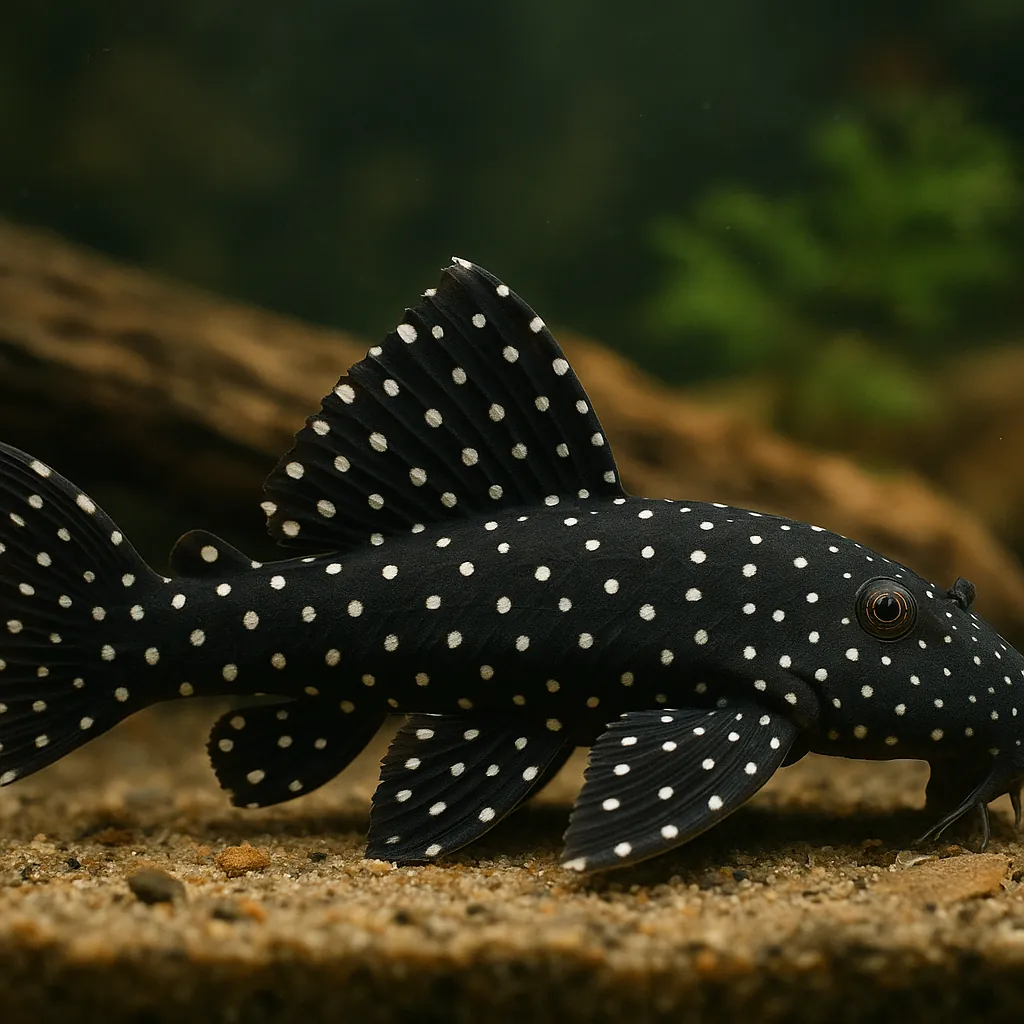
Adonis pleco
Introduction
The Adonis pleco (Acanthicus adonis), also known as the Polka Dot Lyre Tail Pleco, is a striking freshwater fish native to South America. Renowned for its black body adorned with white spots during its juvenile stage, this species captivates aquarists with its unique appearance. However, due to its substantial adult size and specific care requirements, the Adonis pleco is best suited for experienced fishkeepers prepared to meet its needs.
What makes the Adonis pleco appealing to aquarists?
Its distinctive spotted pattern and impressive size make it a standout addition to large aquariums, offering both visual interest and a unique challenge for dedicated hobbyists.
Is the Adonis pleco suitable for beginners?
Due to its large size and specific care requirements, the Adonis pleco is more appropriate for experienced aquarists who can provide the necessary environment and maintenance.
Care and Environment
Caring for an Adonis pleco requires attention to several key factors to ensure its health and well-being.
What is the minimum tank size for an Adonis pleco?
A minimum tank size of 946 liters (250 gallons) is recommended for a single adult Adonis pleco to accommodate its substantial size and territorial nature.
What are the ideal water parameters for this species?
Maintain a temperature range of 24–27°C (75.2–80.6°F), a pH between 6.0 and 7.0, and water hardness of 5–14°N (89.29–250 ppm) to replicate their natural habitat conditions.
Effective filtration is crucial due to the Adonis pleco's size and waste production. A powerful canister filter is recommended to maintain water quality and provide the strong currents they favor. Regular water changes are essential to keep ammonia, nitrite, and nitrate levels in check.
Lighting should be subdued, as Adonis plecos prefer dim environments. Incorporating floating plants can help diffuse light and create a more comfortable setting.
What should be included in the tank setup?
Provide a fine sand or smooth gravel substrate to protect their sensitive mouths during foraging. Include large rocks, driftwood, and caves to offer hiding spots and mimic their natural environment. Ensure all decorations are securely placed to prevent toppling due to the fish's size and strength.
Adonis plecos are omnivorous with a preference for protein-rich foods. Their diet should include sinking pellets, algae wafers, blanched vegetables like zucchini and cucumber, and occasional meaty foods such as bloodworms or shrimp.
Are there any specific challenges in keeping Adonis plecos?
Yes, their large size, territorial behavior, and substantial waste production pose challenges. They require spacious tanks, careful selection of tank mates, and diligent maintenance to ensure a healthy environment.
Origin and Habitat
The Adonis pleco hails from the river basins of South America, particularly the Amazon River in Brazil and Peru. In the wild, they inhabit fast-moving, well-oxygenated waters with abundant rocks, driftwood, and caves that serve as natural hiding spots. These environments feature strong currents and warm, slightly acidic to neutral water, conditions that should be replicated in captivity to promote their well-being.
What type of environments do Adonis plecos prefer in the wild?
They thrive in large river systems with strong currents, ample hiding spots, and warm, slightly acidic to neutral water conditions.
Why is it important to mimic their natural habitat in an aquarium?
Replicating their natural environment helps reduce stress, encourages natural behaviors, and supports overall health and longevity.
Temperament and Compatibility
Juvenile Adonis plecos are generally peaceful, but as they mature, they become increasingly territorial and can exhibit aggressive behavior, especially towards other bottom-dwelling fish.
Can Adonis plecos be kept with other fish?
They can coexist with similarly sized or larger, robust fish that occupy different areas of the tank, such as large cichlids or arowanas. However, they should not be housed with other plecos or bottom-dwelling species to prevent territorial disputes.
How can aggression be minimized in a community tank?
Providing ample hiding spots, such as caves and driftwood, can help reduce aggression by allowing each fish to establish its own territory. Ensuring the tank is spacious enough to accommodate all inhabitants comfortably is also crucial.
Interesting Facts
The Adonis pleco is notable for its dramatic transformation in appearance as it matures. Juveniles display a striking pattern of white spots on a black body, which gradually fade as they grow, resulting in a more uniform dark coloration.
How large can Adonis plecos grow?
In captivity, they can reach up to 24 inches (61 cm), but in the wild, they have been known to grow even larger.
Is breeding Adonis plecos in captivity common?
Breeding Adonis plecos in captivity is rare due to their size and specific environmental requirements. There are no well-documented cases of successful breeding in home aquariums.
Sources
All information in this article has been gathered from the following reputable sources:
Overview
Recommended Tank Size 396.3 Gallons (for optimal conditions and to accommodate their large size) |
Minimum Group Size 1 |
Minimum Tank Volume 249.9 Gallons |
Maximum Adult Length 24 inches |
Average Adult Length 19.7 inches |
Shoaling (6+ required) No |
Preferred Water Type Freshwater, soft to moderately hard, slightly acidic to neutral |
Temperature Range (°C) 24–27 |
pH Range 6.0–7.0 |
Water Hardness (dGH) 5–14 |
Typical Lifespan (years) 5 years |